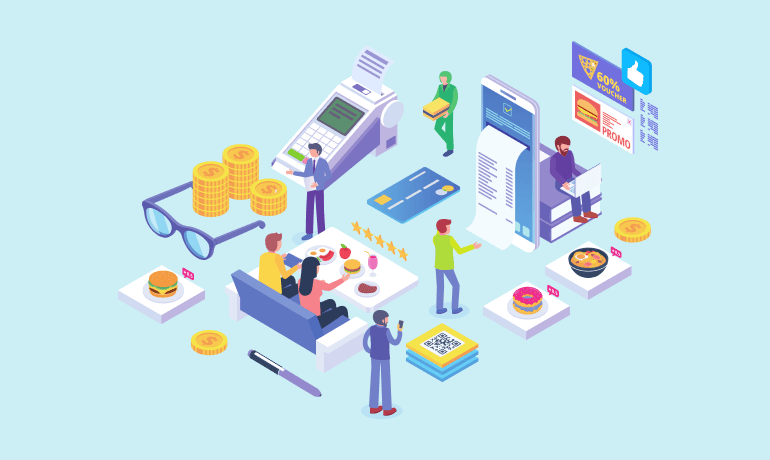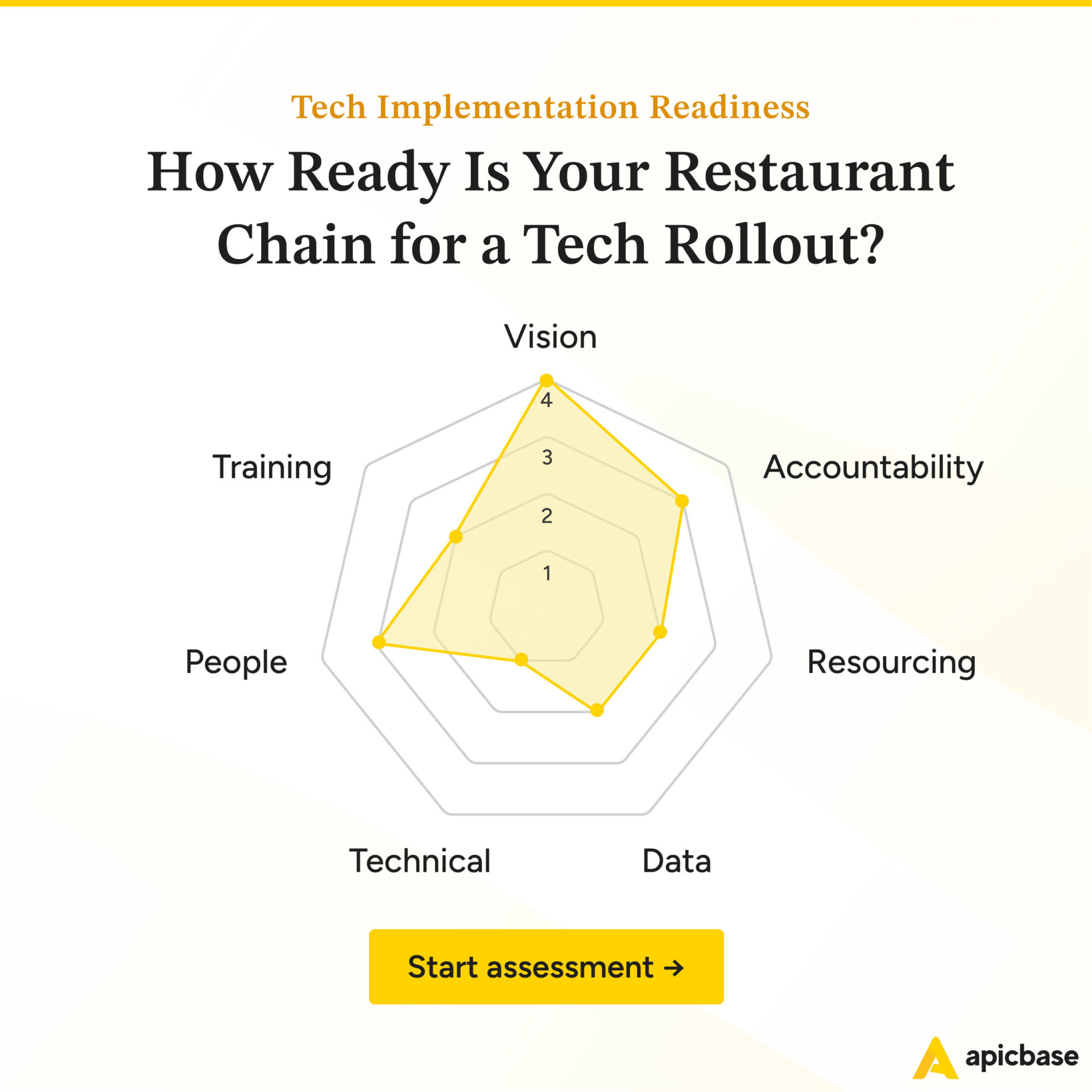Restaurant POS systems have come a long way. Along with the rest of the restaurant operations, the POS is in the midst of digital transformation.
Soon the restaurant industry will be 100% data-driven. And the sales data generated by your restaurant ePOS software plays an important role in that transformation.
For your tech ecosystem to run seamlessly, it is essential that your POS system has APIs that provide clean rich data your other applications can understand.
After all, a modern restaurant ePOS does more than add up the sales numbers. It also enables F&B purchase forecasts, profit calculation, P&L updates and menu engineering.
Even if you don’t see the point of investing in an advanced point of sale system right now, rest assured you will certainly do so when you decide to expand your restaurant business, improve operations or simply eliminate gut feeling from your strategic decision making.
If by now you’re reaching for your wallet, hold on one more sec. Do not take the choice of a new ePOS system lightly because it will affect your business top to bottom.
The right choice of restaurant software will give you a competitive advantage, sure, but make the wrong decision and your clunky, outdated pos software will set you back for years.
But you needn’t worry.
In this article, we’ve listed everything you should know to choose the right restaurant POS system.
What is a Restaurant POS system or ePOS?

A restaurant point of sale system, POS, or ePOS, processes the transactions that happen in a restaurant. Until recently, POS systems tended to run on local servers based in the restaurant. At their simplest, till systems would only add up bills, take payments, and tell the owner how much money they took each day.
A modern restaurant POS does much more. It links to wireless handheld devices to take orders and payments. It is able to handle rich data points and far more complex calculations. Current restaurant POS software integrates with other restaurant applications like online ordering, table reservations and loyalty systems.
And that is only the customer-facing side of a modern restaurant point of sale system. In the backend, restaurant POS systems integrate with platforms like accountancy systems, payroll software and restaurant inventory management software.
In other words, a modern restaurant POS is spread out around the restaurant. The data is no longer stored on local servers but in the cloud. It can be shared in real-time across locations and be accessed by managers on multiple devices.
The decentralized, data-sharing nature of the restaurant POS opens up possibilities to massively improve efficiencies and scalability for multi-outlet hospitality businesses.
How Does Restaurant POS Software Fit into Your Tech Ecosystem
Your POS plays a central part in your tech stack. It handles the customer-facing side of the business. If you want to avoid clunky data silos, your restaurant POS software should integrate seamlessly with your other core systems.
A typical restaurant tech stack might look something like this:
- POS system with the primary goal of revenue optimisation
- F&B management platform, like Apicbase, for food cost control & BoH operations
- Labour management system with the primary function of workforce management
- Accountancy software with the main function of monitoring finances
- BI to dig deeper into the numbers
Remember the Power Rangers?
Think of your tech ecosystem as the giant robot the Power Rangers transform into when they join forces. The colourful rangers are solid fighters on their own, sure, but the giant robot can do way more than they each can individually—wielding a giant laser-shooting sword, for example.
It’s the same for restaurant software. Independently, your solutions should be great; linked together, however, they should become much more powerful, with capabilities that far exceed their individual ones.
That big robot is what the completion of digital transformation in your restaurant operation will look like. All the software in your ecosystem is able to collaborate unhindered and do bigger things than they would be able to do on their own, allowing for unique business insights, unprecedented forecasting, and reliable decision-making, by both staff and management.
6 Vital Features of Restaurant POS Systems [How to Set Your Tech Ecosystem Up for Success]
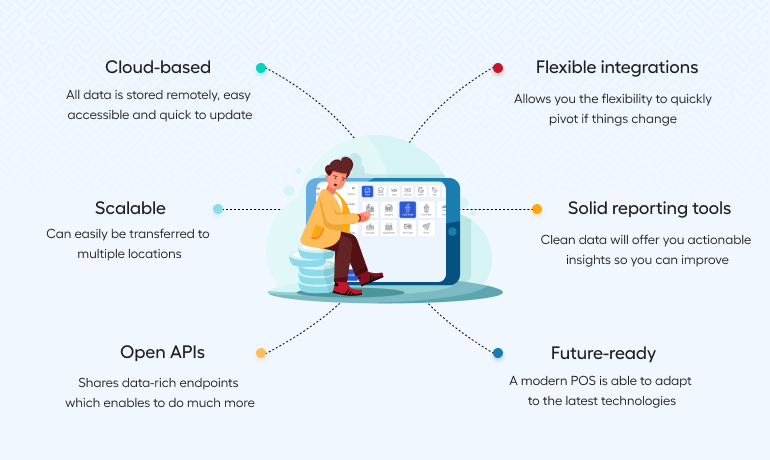
So you’re looking to invest in a new restaurant POS system, and you want to make sure the software supports your expansion goals, is able to handle future tech (that you’re not even aware of right now) and integrate with the other software solutions in your restaurant tech ecosystem?
Great, look no further. There are six things your new restaurant point of sale should be (or have):
- Cloud-based
- Scalable
- Open APIs
- Flexible integrations
- Solid reporting tools
- Future-ready
Let’s go over them in more detail.
1. Cloud-based vs. Server-based Hospitality POS

Traditionally, POS systems were installed locally onto a server in the restaurant. This meant that all the data was stored locally. If the connection to the internet was lost, it was never a problem.
However, it also meant the system had to be installed and maintained by expert technicians at great expense. And it limited the scalability of systems as new hardware would have to be installed at each location.
Modern POS systems are cloud-based, meaning that all the data is stored remotely and can be accessed by multiple decision-makers on any device at any location.
With a cloud-based POS, updates and new features can be rolled out quickly and painlessly throughout your organisation.
The biggest advantage of integrating POS with Apicbase is that I’m always one step ahead. All data flows unimpeded. I’m in complete control of operations.

Filip Van Hoeck
Founder & COO of multi-unit restaurant brand Poule & Poulette
2. Multiple Locations – Restaurant Point of Sale with Room to Scale
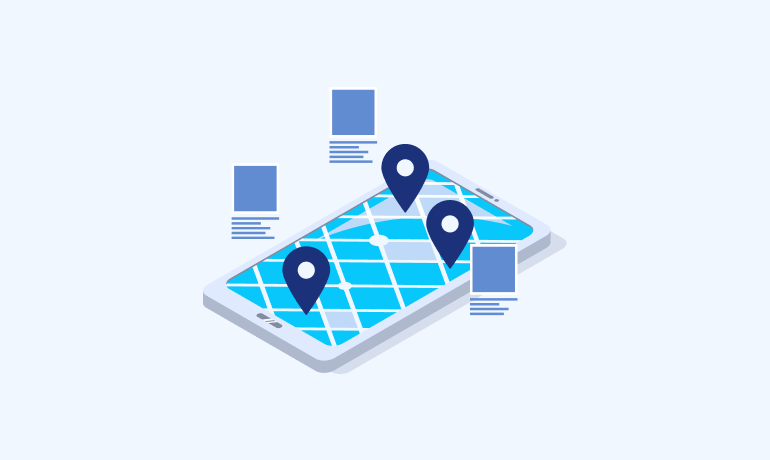
If one of your goals is to scale up fast, you need a POS that can handle your expansion. You don’t want to start from scratch at every location. You need a cloud-based POS, connected to your other systems, that can easily be accessed in new locations.
A POS with scalability built-in is able to handle big data from multiple locations and keep all of your outlets updated with the latest updates and features.
Your managers will be able to review, process and compare the performance of every location, making managing multiple locations remotely a reality – which is essential if you’re hoping to stay on top of operations when expansion is in full swing.
The right tech stack is second only in importance to location when you’re growing a restaurant business. And your POS is an essential component of your tech ecosystem.
See restaurant ePOS systems that integrate with Apicbase. We are setting up new POS integrations all the time. Kindly, contact our sales team if your point-of-sale isn’t on the list. Chances are we’re already working on it.
3. Restaurant POS Software with Open APIs for Data-rich Integrations

In the modern restaurant business, your POS needs to integrate with other systems, like your delivery partners, inventory tech, kitchen display system, and more. But if you want to get the most out of your tech ecosystem, it should go further.
Your POS shouldn’t only be able to talk to your other systems, it should do so with data-rich API endpoints.
A POS with basic API will, for example, only share the name of a dish with the stock management system, which it will use to update theoretical inventory levels. And that’s it. But with data-rich endpoints, it can do so much more.
Apicbase for example will not just keep track of stock levels but will also provide actionable insights into businesses performance by category, time, product and much more.
In other words, you’ll get much more out of your restaurant ePOS when it has an open API that is able to share information-rich data.
It’s the sort of choice that greatly impacts your restaurant’s food and beverage tech strategy.
So if you want to improve efficiencies, reduce waste, and ultimately increase your bottom line, then integrations are essential for your ePOS to be future-proof.
4. The Right Point of Sale Gives Your Restaurant the Ability to Pivot
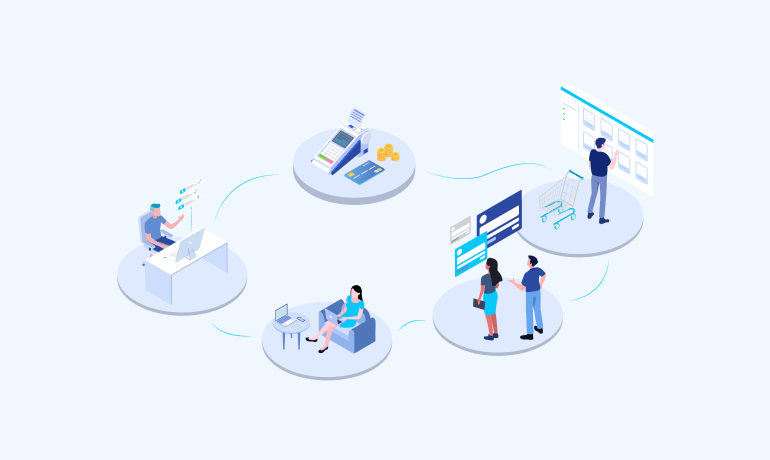
A cloud-based POS with open APIs offers you the flexibility to pivot quickly when things change – and things change all the time. When a shift occurs, you can connect new software to your POS to take the new challenges head-on.
Many restaurant chains, for instance, were forced to roll out online ordering and food delivery during the pandemic, something they may never even considered doing before.
Those with a POS system that was able to integrate with delivery platforms and partner with online ordering tech were able to quickly add this capability and had a much better chance of staying afloat.
Since more disruption is inevitable and with an uncertain future ahead of us, the smart move is to be ready to pivot at a moment’s notice.
5. Restaurant POS Software with Solid Reporting for Data-driven Insights

Having rich data API endpoints and a consistent flow of clean data is great for the reasons we’ve mentioned. But if you can’t access it and get insights from it, you’re not getting the most from your data.
Your restaurant POS should be able to provide you with sales data that is sorted, organized, and useful. Your data should be accessible and shareable in a consistent format. It has to be complete and free of errors, like duplicate entries, or corruption.
If not you’ll fall victim to what is known as GIGO. GIGO is short for Garbage in, Garbage Out. If the data from your ePOS is weak, incomplete or unreadable it will pollute the information in your whole tech stack and render all reports useless.
With clean data, you can share information between systems without getting errors and crashes. Clean data from your ePOS fuels your other systems, allowing them to perform higher-level functions like menu engineering, procurement management, forecasting and margin monitoring.
Look for a POS that will keep your data clean and offer actionable insights that you can use to improve every aspect of your operations. The reporting doesn’t have to come from the POS, but to get proper insights from your BI and reporting tools, your POS must feed the right data to them.
Garbage in, Garbage Out. If the data from your ePOS is incomplete or unreadable it will pollute the information in your tech stack and render all reports useless.
6. Future-proof Restaurant ePOS

The restaurant industry is undergoing a full-scale digital transformation. And not just in terms of systems being in the cloud and connected to the internet and each other. Machine learning and AI are increasingly being adopted by forward-thinking brands in the restaurant industry. To dramatic effect.
Revolutionary new tools like advanced analytics and forecasting, automated procurement, and automation to streamline FoH operations, have the potential to cut waste and improve efficiencies at an unprecedented scale.
Restaurants are increasingly using an omnichannel strategy to engage guests at every touchpoint. Omnichannel means providing a consistent customer experience no matter how they interact with your restaurant.
A customer might find your restaurant searching online for example, then order on your website, then later call to book a table to dine-in. An omnichannel restaurant strives to provide the same branding, customer service, and smooth experience online and offline, across all of these channels.
Using a combination of technologies and clean data flow, omnichannel success means labour costs can be reduced while actually improving the customer experience.
But to take advantage of these advances, your POS must be able to adapt and integrate with the latest technology as it emerges.
Conclusion?
A modern POS must have open APIs, be cloud-based, and be agile to be ready for the future.
Your Restaurant POS is a Key Piece in Your Tech Ecosystem
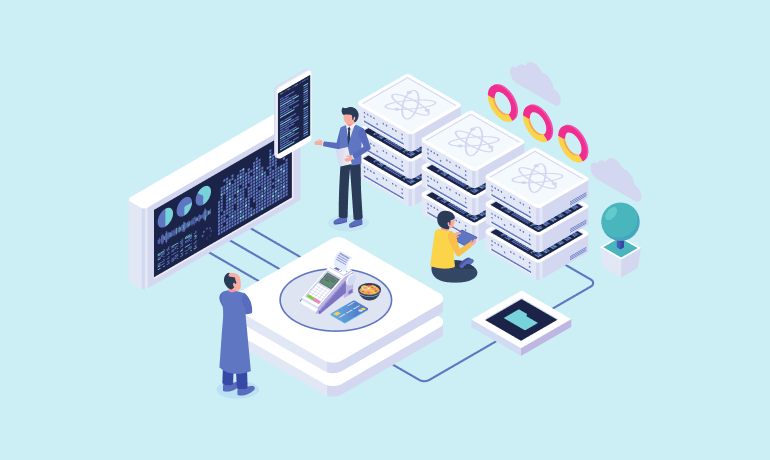
Restaurant POS systems are the central node through which financial, inventory and ordering data flows. As an essential part of your tech ecosystem, yours needs to perform the functions we’ve discussed above and be able to provide clean, rich, actionable data to the rest of your tech stack.
Apicbase was built to integrate seamlessly with modern cloud-based ePOS systems for the foodservice industry and to use the data provided to help you make the most out of the digital transformation that is sweeping the restaurant industry.
Apicbase Integrates With Leading POS Systems
- Booq
- Countler
- Deliverect
- Eposnow
- Gastrofix
- Golfmanager
- Ikentoo
- Lightspeed
- Micros
- Mpluskassa
- Revel
- Square
- Trivec
- Untill
- Vectron
Apicbase is growing fast and we are continuously building new POS integrations. If you can’t find your point-of-sale system in the list, please check our integrations page for updates or contact our sales team.
If you want to see the integration in action then tap the button below for a demo.👇
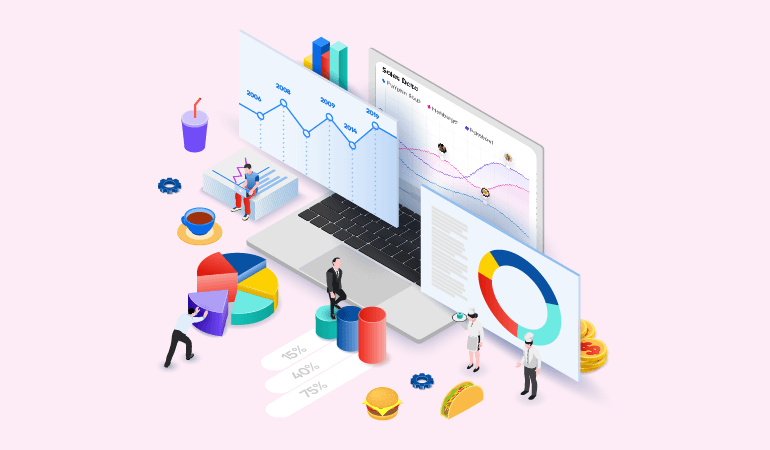
Your POS x Apicbase = Magic
Matching sales to inventory (the things you can actually touch, see and smell) used to be next to impossible. But with Apicbase, all it takes is the tap of a button to make it happen.

